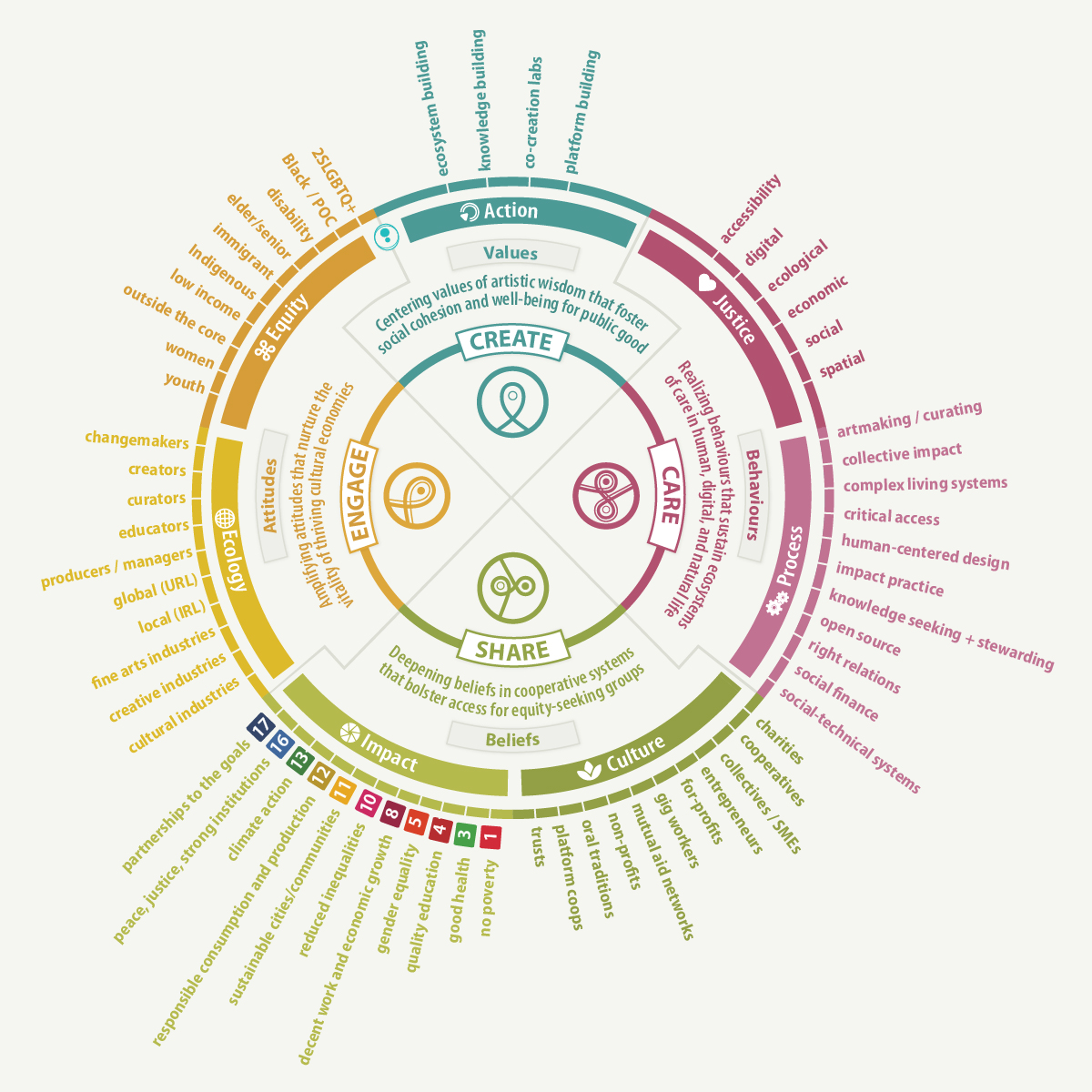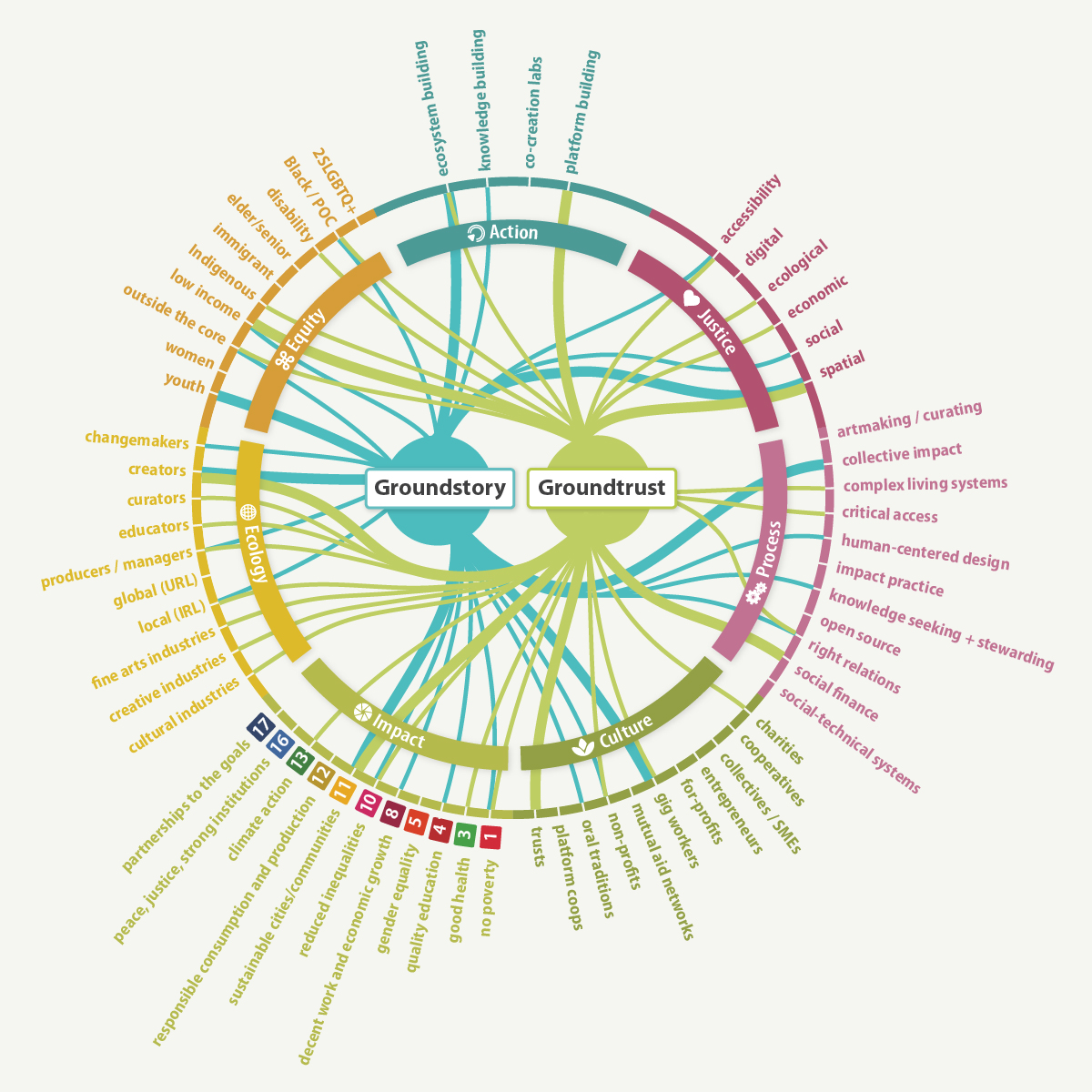Last month, we shared the first preview of our evolving vision as a Caring Enterprise with four archetypal elements rooted in the wisdom of the arts: Create, Engage, Share, and Care.
While still a work-in-progress, today we would like to take the next step by sharing two visual models:
- In the first diagram, we introduce a conceptual model that underpins our vision as a caring enterprise boosting positive systems change with, by, and for the arts. The current model draws upon wise practices from social innovation and community-engaged arts.
- In the second diagram, we illustrate how this conceptual model is applied to two of our spatial justice initiatives, Groundstory and Groundtrust.
Visual Model
Elements
This infographic strives to summarize ArtsPond’s approach as a Caring Enterprise in the arts. It is a circular model with teal, orange, green, and reddish-purple segments and texts on a light taupe background. In the center of the circle are the four essential elements that guide our vision. These include:
- CREATE: Centering values of artistic wisdom that foster social cohesion and well-being for public good
- ENGAGE: Amplifying attitudes that nurture the vitality of thriving cultural economies
- SHARE: Deeping beliefs in cooperative systems that bolster access for equity-seeking groups
- CARE: Realizing behaviours that sustain ecosystems of care in human, digital, and natural life.
Perspectives
Moving outwards from the center, the next level outlines seven interconnected perspectives or lenses that help situate our various efforts related to the four elements. Derived from wise practices in community-engaged arts and social innovation, these seven perspectives include Action, Equity, Ecology, Impact, Culture, Process, and Justice. They each root back to one of the four guiding elements, as in the following:
- CREATE
- Action
- ENGAGE
- Equity
- Ecology
- SHARE
- Impact
- Culture
- CARE
- Process
- Justice
Priorities
At the outer edge of the framework are 63 priorities that make up ArtsPond’s evolving business model. In the realm of Impact, there are 11 different goals that we are committed to from the United Nations’ 2030 Global Sustainable Development Goals. Starting from the top, the full model is as follows:
- Action
- Ecosystem building
- Knowledge building
- Co-creation labs
- Platform building
- Equity
- 2SLGBTQ+
- Black / POC (people of colour)
- Disability
- Elders / seniors
- Immigrants
- Indigenous
- Low income
- Outside the core (suburban, rural, remote)
- Women
- Youth
- Ecology
- Changemakers
- Creators
- Curators
- Educators
- Producers / managers
- Global (URL)
- Local (IRL)
- Natural (NRL)
- Fine arts industries
- Creative industries
- Cultural industries
- Impact (2030 Global Sustainable Development Goals)
- 1-No poverty
- 2-Good health
- 4-Quality Education
- 8-Decent work and economic growth
- 10-Reduced inequalities
- 11-Sustainable cities and communities
- 12-Responsible consumption and production
- 13-Climate action
- 16-Peace, justice, and strong institutions
- 17-Partnerships to the goals
- Culture
- Charities
- Cooperatives
- Collectives / SMEs
- Entrepreneurs
- For-profits
- Gig workers
- Mutual aid networks
- Non-profits
- Oral traditions
- Platform coops
- Trusts
- Process
- Artmaking / curating
- Collective impact
- Complex living systems
- Critical access
- Human-centered design
- Impact practices
- Knowledge seeking / stewarding
- Open source
- Right relations
- Social finance
- Social-technical systems
- Justice
- Accessibility
- Digital
- Ecological
- Economic
- Social
- Spatial
Based on the model above, this second infographic illustrates the relationships between two of our spatial justice initiatives, Groundstory (a collective impact effort on spatial precarity and gentrification in the arts) and Groundtrust (cultural land trust literacy and feasibility study).
With overlapping lines radiating out from two circles in the center (blue for Groundstory, and green for Groundtrust), this diagram serves to highlight which of the 63 priorities these two initiatives are focused on. Some lines are thicker than others, denoting increased importance. Visually, the diagram looks like bicoloured eyes with overlapping streams or roots branching outward. The priorities are as follows:
Groundstory
- Actions
- Ecosystems building (priority)
- Knowledge building
- Equity
- Black / POC
- Low income
- Outside the core
- Youth (priority)
- Ecology
- Creators (priority)
- Producers / managers
- Local (IRL)
- Impact
- 1-No poverty
- 4-Quality education
- 8-Decent work and economic growth
- 10-Reduced inequalities
- 11-Sustainable cities / communities (priority)
- Culture
- Gig workers (priority)
- Non-profits
- Oral traditions
- Process
- Collective impact (priority)
- Human-centered design
- Knowledge seeking + stewarding
- Right relations
- Justice
- Accessibility
- Social
- Spatial
Groundtrust
- Action
- Ecosystem building
- Platform building (priority)
- Equity
- Black / POC
- Disability
- Indigenous
- Low income (priority)
- Outside the core
- Ecology
- Creators (priority)
- Curators
- Educators
- Producers / managers
- Local (IRL)
- Fine arts industries
- Creative industries
- Cultural industries
- Impact
- 1-No poverty
- 3-Good health
- 10-Reduced inequalities
- 11-Sustainable cities/communities (priority)
- 13-Climate action
- Culture
- Charities
- Gig workers
- Non-profits
- Trusts (priority)
- Process
- Complex living systems
- Critical access
- Right relations
- Social finance (priority)
- Justice
- Accessibility
- Ecological
- Economic
- Spatial (priority)


